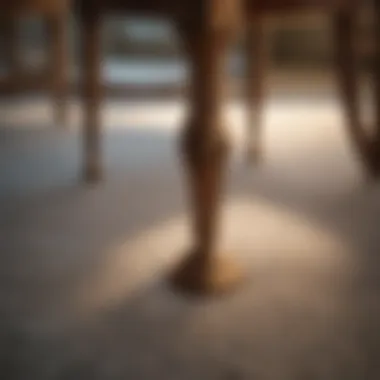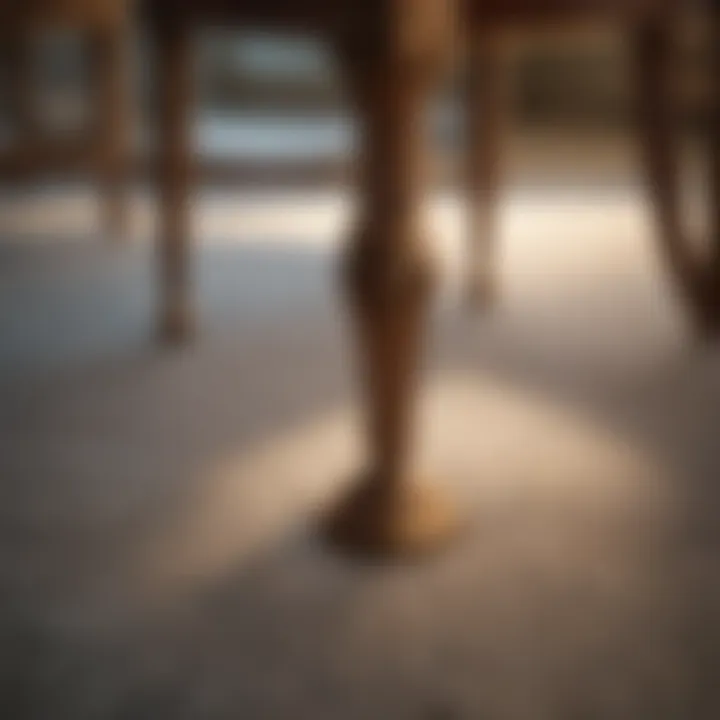Essential Guide to Furniture Cups on Carpets


Intro
Furniture cups may not be the first item on your home improvement checklist, but they play a significant role in preserving the integrity of your carpets. When you think about it, carpets serve as a canvas for our living spaces. They absorb sounds, contribute to aesthetics, and keep homes looking cozy. But heavy furniture sitting atop a plush carpet can create complications. This guide delves into the usually overlooked yet vital relationship between furniture cups and carpets.
What Are Furniture Cups?
Furniture cups are specialized coasters designed to support the feet of furniture items, such as chairs, tables, or sofas, while allowing them to rest on soft surfaces like carpet. The primary aim of these cups is twofold: they protect the carpet from dents and soil degradation caused by weight and movement, and they help distribute the weight of furniture to create stability.
Why Are Furniture Cups Important?
The importance of furniture cups extends far beyond mere aesthetics. Carpets, although resilient, can wear out faster under constant pressure from heavy furniture. This leads to unsightly indentations that can ruin the look of your rooms. Not only that, but furniture cups also help avoid slipping or tipping, which is particularly crucial in households with children or pets. In essence, they act as the unsung heroes of home maintenance, offering both protection and practicality.
Understanding Furniture Cups
Furniture cups play a key role in protecting both your carpets and furniture. They are ubiquitous yet often overlooked elements in home decoration that deserve a substantial discussion. Their importance goes beyond just being a support mechanism; they are integral to the overall longevity and aesthetics of your space. This section explains what furniture cups are, and highlights their benefits, and considerations that come into play when using them.
Definition and Purpose
Furniture cups, essentially small protective bases, are designed to support the legs of furniture pieces. They create a buffer between the heavy weight of the furniture and the soft surface of carpets. By distributing the weight over a larger area, they help prevent damage like indentations or flattening of carpet fibers.
They can be made from various materials, each serving a different purpose—plastic for lightweight furniture, rubber for grip, and metal for durability.
Using furniture cups can be especially beneficial when moving furniture across carpets. They reduce friction and allow for smoother transitions, easing the chore of arranging or cleaning your living spaces.
Importance in Interior Design
In interior design, every choice carries significance, and furniture cups are no exception. They are often the unsung heroes that facilitate various design concepts while preserving the integrity of your flooring. A well-chosen cup not only impacts functionality but can also complement the aesthetic appeal of a room.
Besides practicality, furniture cups contribute to a cohesive look. Homeowners can match the design of the cups to the furniture or the carpet's color and pattern, creating a harmonious environment. Different shapes—round, square, and even custom options—can enhance the overall design theme, such as classic or modern.
A well-planned design scheme includes consideration of these little elements. Overall, furniture cups foster an environment where style and functionality coexist, ensuring your living area remains pristine while showcasing your taste.
"In the world of design, the little things often make the biggest difference, and furniture cups exemplify this beautifully."
By understanding the role of furniture cups in your home, you empower yourself to make informed choices that elevate your space's comfort and style.
Types of Furniture Cups
Understanding the types of furniture cups available and their specific characteristics is crucial for optimizing their use on carpets. Different materials and designs can greatly impact how well furniture cups protect carpets and stabilize furniture. Using the right type aligns with your furniture's weight and the carpet's properties, leading to better overall functionality.
Material Variations
Furniture cups come in various materials, each offering unique benefits and considerations. Choosing the correct material can ensure durability, effectiveness, and compatibility with your home’s aesthetic.
Plastic Options
Plastic options serve as a popular choice for furniture cups due to their lightweight nature and affordability. They are often made from durable polyethylenes or polypropylenes, providing a balance between flexibility and strength. One major advantage is their low cost, making them a practical option for anyone. However, they can lack grip compared to other materials, meaning they may slide if not properly fixed.
Another point to consider is their diverse designs. Many manufacturers offer colorful varieties, allowing you to match them with your furniture or carpet aesthetic. This can add a touch of flair, especially if you’re attentive to those finer details in your home decor.
Metal Variants
Metal variants, on the other hand, stand out for their robust nature. Typically made from steel or aluminum, they can handle significant weight and pressure. This makes them ideal not just for heavier furniture but also for prolonged use. Their sturdiness means they're less likely to deform or break under load, which positions them as a long-term investment.
However, metal cups often come with a higher price tag, which might not be suitable for every budget. Some metal options might also scratch or dent softer carpets if improperly placed. Thus, careful consideration regarding weight distribution and carpet protection is advised when using these cups.
Rubber Choices
Rubber choices provide an interesting compromise between metal and plastic. They excel in providing grip, effectively reducing the chance of slippage. These cups can better adapt to various surfaces, thanks in part to their flexible nature. Rubber cups may also offer noise reduction, absorbing impacts better than harder materials.
On the downside, they may retain dirt and grime more quickly, necessitating regular cleaning to maintain their appearance. They can also wear quicker than metal options, especially if subjected to considerable weight or outdoor conditions.
Shape and Size Considerations
The shape and size of furniture cups are vital for ensuring proper fitting and suitability for different furniture types. A well-sized cup can mean the difference between protection and additional damage to your carpet.


Round vs. Square
In the debate of round versus square furniture cups, it’s important to note that both shapes serve different needs. Round cups can distribute weight evenly across the surface, reducing the risk of indentations in softer carpets. They can slide easier though, which may present issues for heavier items, hence the proper fit is a must.
Conversely, square cups provide more stable support for heavier furniture. They tend to stay in place better, but depending on the design and carpet type, might not be as effective in weight distribution. Thus, the choice between round and square hinges much on your specific furniture and flooring combination.
Custom Sizes
If standard sizes don’t fit your needs, custom sizes for furniture cups can make a significant difference. Getting the right match ensures maximum efficiency in protecting your carpet and stabilizing your furniture. Customized options allow for perfect fitting under various furniture legs, which is especially necessary in unique spaces.
However, they usually come with added costs and longer wait times, compromising convenience for tailored precision. Regardless, investing in correctly sized furniture cups can yield significant benefits in durability and functionality.
Installation Techniques for Furniture Cups
When it comes to furniture cups, the installation process is just as crucial as selecting the right type. Proper installation ensures that these small but mighty tools fulfill their purpose—protecting carpets and stabilizing furniture. It’s not just about slapping them on the bottom of a chair; it’s about preparing the surface properly and securing them in a way that enhances their effectiveness.
Understanding the nuances of installation can save homeowners from problematic situations, such as unsightly carpet dents or furniture wobble. In this section, we’ll delve into the key steps for installing furniture cups on your carpet, focusing on how to prepare the carpet surface and securely attach the cups.
Preparing the Carpet Surface
The first step before even thinking about placing furniture cups is getting the carpet ready. Cleaning and smoothing out the area where the cup will rest is essential. Dust bunnies or lint lurking underneath can obstruct a solid fit, leading to improper alignment or movement.
Here are the steps for preparing the carpet surface:
- Vacuum Thoroughly: Grab your vacuum cleaner and give the area a good once-over. You’re looking to remove any dirt, debris, and pet hair that might be hidden.
- Inspect for Wear: Take a moment to examine the carpet. Check for any fraying, stains, or indentations. If the carpet is old and damaged, the furniture cup might not adhere properly.
- Spot Clean if Necessary: If you find any stains, consider a gentle carpet cleaner. Limiting excess moisture during cleaning also ensures that the carpet fibers don’t get compromised.
By ensuring the carpet is clean and evenly laid out, you're setting the stage for stable placement of the furniture cups, making your job a lot easier downstream.
Securing the Furniture Cup
Once the carpet is prepared, it’s time to secure the furniture cups. This can be done through various methods including adhesive solutions or anchor methods. Each technique comes with its own set of pros and cons, so let’s unpack them further.
Using Adhesives
Using adhesives to secure furniture cups provides a reliable hold that can endure the test of time and movement. When utilizing them, there are a few factors to consider:
- Strong Bond: Specially formulated adhesives designed for carpets can create a strong bond that significantly reduces the risk of slippage or displacement. This is particularly beneficial in high-traffic areas of the home where furniture is regularly moved or adjusted.
- Ease of Application: Applying adhesive is relatively straightforward. Generally, you’d simply apply a suitable glue to the bottom of the furniture cup and press it down firmly onto the carpet.
- Flexibility: Choose adhesives that allow for some level of repositioning. Sometimes, you may want to move the furniture.
However, there are a couple of drawbacks. Adhesives can sometimes leave a residue on the carpet, or if it’s ever necessary to remove the furniture cup, it may damage the fibers underneath.
Anchor Methods
On the other side of the coin, using anchor methods can provide a more permanent solution depending on the weight of the furniture.
- Mechanical Fixing: Anchors offer a robust way to secure the furniture cups, often involving screws or other fasteners that can penetrate the carpet surface into the subfloor. This means they stick with the furniture for good.
- Stability: If your furniture tends to shift around—like a rocking chair or office chair—anchors provide a steadier hold so you won't have to keep adjusting them.
- Long-Lasting Solution: This method can stand up better over the years, making it a cost-effective choice in the long run.
The major downside is the labor involved. While they’re an excellent option for stability, installation is a bit more cumbersome and requires some skill with tools. It’s not a job for the faint of heart if you aren't comfortable with drills or installing anchors.
Benefits of Using Furniture Cups on Carpet
Using furniture cups on carpet is not just a matter of personal preference; it’s a pivotal step toward preserving both your flooring and your cherished furnishings. This article section will outline the various advantages that these simple yet effective tools bring to the table, including prevention of damage to your carpets and the stabilization of heavy furniture.
Protecting Carpets From Damage
Furniture can wreak havoc on carpets if not managed properly. When you think about it, the pressure exerted by heavy items can lead to several issues, including permanent indentations and excessive wear. This is where furniture cups come into play, acting as a protective barrier between your furniture and carpet.
Preventing Indentations
One of the most notable features of preventing indentations is the way it distributes weight. A heavy piece of furniture, when placed directly on the carpet, creates a localized pressure point which can compress the fibers and create depressions. Furniture cups help spread that weight over a larger area, thereby minimizing the chances of those ugly dips.
This feature is particularly beneficial for those who value the appearance of their carpets—who wouldn’t want to keep them looking fresh and plush? In addition, preventing indentations is a cost-effective solution, saving homeowners from costly carpet repairs or replacements.
On the flipside, while these furniture cups are often effective, their performance can vary depending on the material used and the weight of the furniture. If not selected wisely, some options might not hold up well under a heavy load.
Reducing Friction


Reducing friction is another critical aspect when discussing the benefits of furniture cups. Friction can result in unnecessary wear and tear, not just on the carpet but also on the furniture pieces themselves. By elevating the legs of the furniture slightly, furniture cups mitigate the friction generated during movement, whether it’s from sliding chairs or the routine rearranging of furniture.
This characteristic makes furniture cups a solid choice, particularly in homes where mobility is frequent. They can lead to longer-lasting carpets and furniture because they lessen the chances of snagging and ripping. Homes with children or pets will especially appreciate this feature, as high traffic can accelerate damage.
Ultimately, the choice to include furniture cups in your home setup not only preserves the aesthetic appeal but also saves you from the headache of frequent maintenance and costly repairs. Depending on the variety you choose, they can help you keep your space looking polished without losing functionality.
Stabilizing Heavy Furniture
Heavy furniture has a tendency to tip or wobble, especially when placed on softer surfaces such as carpet. This not only poses a risk for items tipping over but can also lead to uneven wear on your flooring surfaces. Furniture cups provide a solid footing that helps to stabilize even the heaviest of your belongings, ensuring that they stay grounded instead of shifting with the slightest touch.
In doing so, they offer peace of mind, particularly in homes with children or pets, where a toppled item could result in an accident. By opting for furniture cups, one is essentially investing in a solution that safeguards both the furniture and the floor beneath it.
In summary, the integration of furniture cups in a carpeted environment serves multiple purposes— from protecting carpets from damage to offering stability for even your heaviest pieces. With that in mind, homeowners should strongly consider these practical tools to enhance their living spaces.
Aesthetic Impacts of Furniture Cups
When considering furniture stability and protection, it's easy to overlook the aesthetic effects that furniture cups can have. In addition to their functional role, these small yet significant accessories can play a crucial part in how a room looks and feels. They can blend seamlessly into the surroundings or provide a discreet choice that enhances the overall style of a space. Understanding the aesthetic impacts helps homeowners make informed decisions that reflect their personal taste while ensuring practical benefits.
Design Integration
Color Choices
Color choices are vital in determining how furniture cups will affect the overall appearance of a room. When selecting a hue, it's essential to consider the existing color palette of the furniture and the carpet. A well-matched color can create a cohesive look, while an intentionally contrasting color can become a statement piece. For instance, black or dark brown furniture cups may complement darker carpets beautifully, while brighter shades can add a pop of color against neutral tones.
The key characteristic of appropriate color choices is simplicity. A straightforward design can easily integrate into any decor, making it a popular option for homeowners looking to enhance their interiors without causing disruption. However, one potential disadvantage is when the color fades over time, which can lead to a mismatched appearance in the long run.
Patterns and Textures
Patterns and textures can add another layer of dynamism to the aesthetics of furniture cups. From floral prints to geometric designs, these options provide the opportunity for personalization. Choosing patterns that echo existing decor—like a rug pattern—can create visual harmony in the room.
One significant benefit of patterns is that they can conceal wear and tear better than solid colors, as patterns tend to camouflage scuffs and scratches. However, opting for overly intricate designs can clash with other decor elements, leading to a disjointed overall appearance. Thus, balance is key when selecting furniture cups with patterns and textures.
Concealing Furniture Cups
Concealing furniture cups allows homeowners to maintain the elegant look of their interior while ensuring that functionality is not compromised. While these cups often serve a practical purpose, their visibility can sometimes detract from the intended aesthetic.
Under Furniture Placemats
Using under furniture placemats can be an effective method of concealment. These mats provide not only a surface for the furniture cups but also help keep the furniture in place, reducing movement. The overall effect can create a more refined, polished appearance.
The unique feature of placemats is their versatility—available in various sizes, colors, and materials, they can easily blend with the carpet or adorn contrasting designs. However, one downside is that, depending on the placement, they might make it more challenging to clean under the furniture. Homeowners must weigh the aesthetic enhancement against practical concerns about upkeep.
Matching with Carpets
Matching furniture cups with carpets is an art in itself. The idea is to find harmonizing colors and textures that create a seamless integration in the room. This method can subtly minimize the visual impact of furniture cups while still reaping their benefits.
The major advantage of this approach is that it often leads to a cleaner, more cohesive look. However, homeowners must be wary about selecting cups that are too similar to the carpet color, as they might lose their functional benefits.
Care and Maintenance of Furniture Cups
When it comes to ensuring the longevity and functionality of furniture cups, proper care and maintenance cannot be overstated. These small but mighty accessories play a crucial role in protecting your carpets and stabilizing your furniture. Over time, neglecting their upkeep can lead to reduced efficiency, potential damage to your flooring, and even aesthetic inconsistencies. To keep everything in tip-top shape, you need to familiarize yourself with a few essential tasks.
Regular Cleaning Practices
Just like any other home accessory, furniture cups accumulate dust and grime. Regular cleaning is essential not only for appearance but also for maintaining their functionality. Here are some straightforward practices to consider:
- Wipe Down: Use a damp cloth to wipe the surface of the furniture cups. A gentle cleaning solution can be used if there are stubborn stains.
- Avoid Harsh Chemicals: Chemicals might damage the material, particularly if you’re using rubber or painted surfaces. Stick with mild, natural products.
- Inspect for Buildup: Regularly check for any buildup of dirt or debris that might impede their effectiveness. This is especially important in high-traffic areas.
- Frequency: Ideally, clean them every couple of weeks or at least once a month, depending on your home's dust levels.
By establishing a routine, your furniture cups will not only look appealing but also perform their duties effectively.
Assessing Wear and Tear
With time, even the best items can start showing signs of wear and tear. Identifying these signs can help in deciding whether it’s time for a replacement or if they can still be used. Here are a few key aspects to consider:
- Look for Cracks or Discoloration: Any visible cracks may signal that the cup has weakened, while discoloration could indicate that the material has degraded.
- Check Stability: If you notice your furniture rocking or becoming unstable, check the furniture cups; they might not be gripping the carpet as securely as they once did.
- Evaluate Pressure Marks: If your furniture leaves indentations on the carpet even after moving, it’s a sign that the cups might be insufficient for the weight.
- Lifespan Consideration: Generally, furniture cups can last from a couple of months to a few years, depending on the material and usage intensity. Consider replacing them if they start showing significant wear.
"The secret to prolonging the life of furniture cups lies not just in their initial choice but in their ongoing care."
Maintaining furniture cups doesn't just enhance their appearance; it also extends their service life, which saves you a few bucks in the long run. By being proactive in your cleaning and assessment, you create a safer and more aesthetically pleasing environment in your home.
Choosing the Right Furniture Cups for Your Needs
Selecting the appropriate furniture cups is crucial for a successful performance on carpets. The right choice not only enhances stability but also protects the carpet from damage, ensuring longevity. Given the various types of carpets, understanding which furniture cups to use can help you avoid certain pitfalls and maximize the benefits.


In this section, we will explore how to evaluate the different carpet types and how to match the furniture weight with adequate furniture cups. This knowledge empowers homeowners and housewives alike, allowing them to maintain the aesthetic appeal of their indoor spaces while prioritizing practical considerations.
Evaluating Carpet Types
Delicate Carpets
Delicate carpets, often made from soft fibers like silk or high-quality wool, require special attention. Their key characteristic is their fragility – a pronounced sensitivity to weight and pressure. When under heavy furniture, these carpets can easily develop unsightly indentations that are tough to reverse.
Choosing furniture cups designed for delicate carpets becomes essential. A beneficial aspect of these carpets is their luxurious look and feel, often elevating the overall elegance of a room. However, their unique feature of softness means they can be more prone to wear and tear. Adequate protection is necessary to maintain their pristine condition.
Opting for lightweight yet effective furniture cups, perhaps made from cushioned rubber, can significantly reduce the risk of damage. An advantage here is the grip they provide, preventing unwanted slippage during movement. Yet, homeowners should be cautious to ensure that the chosen cups don’t weigh down overly, as they could further gouge the carpet.
High-Traffic Area Carpets
On the other end of the spectrum, high-traffic area carpets are robust and designed to withstand wear and tear. Their main trait is durability; they can endure the pounding from foot traffic, kids, and pets without showing much in the way of damage. These carpets are often synthetic, often paired with a tighter weave.
For this type of carpet, using furniture cups that balance support without excess weight is advantageous. A common approach is to select hard plastic or metal options that can distribute weight evenly, preventing any significant imprint. The unique, rugged nature of these carpets makes them a popular choice for families and active households.
However, a downside can emerge if the furniture cups are not carefully chosen. Heavy furniture coupled with inadequate cups can lead to scuff marks or scratches, undermining the carpet's longevity in the long run. Thus, understanding the specific needs of high-traffic carpets helps in making wise decisions.
Matching with Furniture Weight
Finally, ensuring that the furniture cups are compatible with the weight of your furniture is vital for overall functionality. Heavy furniture requires robust support to avoid sinking into the carpet. In contrast, lighter pieces need less bulk.
Evaluating the combinations of weight and type effectively bridges any gaps. For instance, a large sofa set may require substantial, wide-based cups to bear it adequately. In contrast, a delicate side table might only need a modest, lower profile cup.
By paying attention to these details, homeowners can make informed choices that bolster both the appearance and functionality of their carpeted areas. With proper care and understanding, the right furniture cups can maximize the lifespan of carpets, keeping them looking fresh for years.
"Investing in the right furniture cups can safeguard your investments, ensuring both carpet and furniture retain their charm."
Ultimately, the process of selecting furniture cups tailored to the varieties of carpet and their intended use can be a game changer in creating a harmonious living space.
Environmental Considerations in Furniture Cup Production
In recent years, the focus on environmental sustainability has become more pressing, not only for large industries but also for home improvement products like furniture cups. Understanding the ecological footprint of these seemingly simple items is essential, especially in a world where every choice counts toward a healthier planet. Opting for furniture cups made with an emphasis on environmental considerations can lead to lasting benefits for both the consumer and the Earth.
The production of furniture cups often involves the use of materials that can have varying impacts on the environment. For homeowners and decorators, being aware of these factors can not only ease personal guilt but also contribute to a broader movement toward sustainability. It's not just about aesthetics or functionality; it's about making choices that reflect a commitment to environmental stewardship.
Sustainable Materials
When selecting furniture cups, the materials used in their creation should set off alarm bells for the environmentally conscious. Sustainable materials are those sourced responsibly, ensuring that natural resources are not depleted and harmful extraction methods are avoided.
For example, bamboo is becoming increasingly popular. This fast-growing grass is highly renewable and when harvested ethically, it can offer a sturdy yet lightweight option for furniture cups. Moreover, cups made from recycled plastics not only divert waste from landfills but also reduce the need for new raw materials, creating a circular economy. Here are some key sustainable materials to consider:
- Bamboo: A versatile, renewable source that grows rapidly.
- Recycled plastics: Reduces waste and demand for virgin materials.
- Natural rubber: Sourced from rubber trees, offering durability without synthetic chemicals.
It’s also important to look at the certifications or labels on the product. Items marked with eco-friendly certifications often indicate compliance with sustainable practices, providing peace of mind.
Recyclability of Furniture Cups
The recyclability of furniture cups cannot be overlooked when considering their environmental impact. After all, if furniture cups can be recycled effectively, their overall footprint can be significantly reduced. Items that end up in the landfill contribute to pollution and waste, while those that can be recycled allow for resources to be repurposed rather than used up.
For instance, furniture cups crafted from high-density polyethylene (HDPE) are not only robust for heavy furniture but are also 100% recyclable. To facilitate this, homeowners should check local recycling guidelines and ensure they are disposing of these materials correctly when they reach the end of their life cycle.
"Every piece counts, and choosing furniture cups that can be reused or recycled reflects a commitment to sustainability that resonates with many homeowners today."
Finale
In this discussion, the conclusion is a vital component that ties all the threads of furniture cup optimization together. What’s clear is that understanding furniture cups gives housewives and homeowners a plethora of benefits that extend far beyond mere carpet protection. Not only do these small yet indispensable items serve a practical purpose, but they also play a role in enhancing the aesthetic appeal and overall longevity of both furniture and flooring surfaces.
Recapping Key Insights
To recap, furniture cups are not just trivial accessories. Here are the key takeaways that stand out in this article:
- Protection Against Damage: Furniture cups serve to prevent carpets from sustaining wear and indentations caused by heavy weights. This prolongs the life of your flooring, saving you from costly replacements or repairs down the line.
- Stabilization of Furniture: When applied correctly, these cups can help hold furniture in place, reducing slippage and the associated risk of accidents. More stable furniture not only ensures safety but also maintains the intended design integrity of your space.
- Aesthetic Enhancement: With various designs, materials, and choices available, furniture cups can be integrated seamlessly into your home’s decor, striking a balance between function and style. Choosing colors or patterns that complement your furnishings can make them an unnoticed hero.
- Maintenance Simplicity: Caring for furniture cups is straightforward. Regular cleaning and inspection can enhance their functional longevity.
The article lays down a foundation where both function and form converge, allowing you to invest in your home with confidence.
Future Trends in Furniture Cup Design
Looking ahead, the design and production of furniture cups are likely to evolve significantly. Here are some expected trends:
- Eco-Conscious Materials: With growing consumer awareness, more brands are likely to embrace sustainable materials in their production lines. Using recycled plastics or biodegradable options could become the norm, aligning with the values of the environmentally aware homeowner.
- Smart Technology Integration: Although still in its infancy, the concept of smart furniture cups that can adapt based on weight distribution could emerge. Imagine furniture cups equipped with sensors, providing feedback on the stability of your couch or table, alerting you before any potential slipping occurs.
- Customization Options: As personalization continues to drive consumer preferences, brands might start offering customizable furniture cups. Homeowners could choose exact dimensions, colors, and patterns, ensuring a perfectly tailored solution.
- Enhanced Grip Features: The functionality of furniture cups may be improved with better grip technologies, preventing slippage and keeping furniture firmly anchored.







